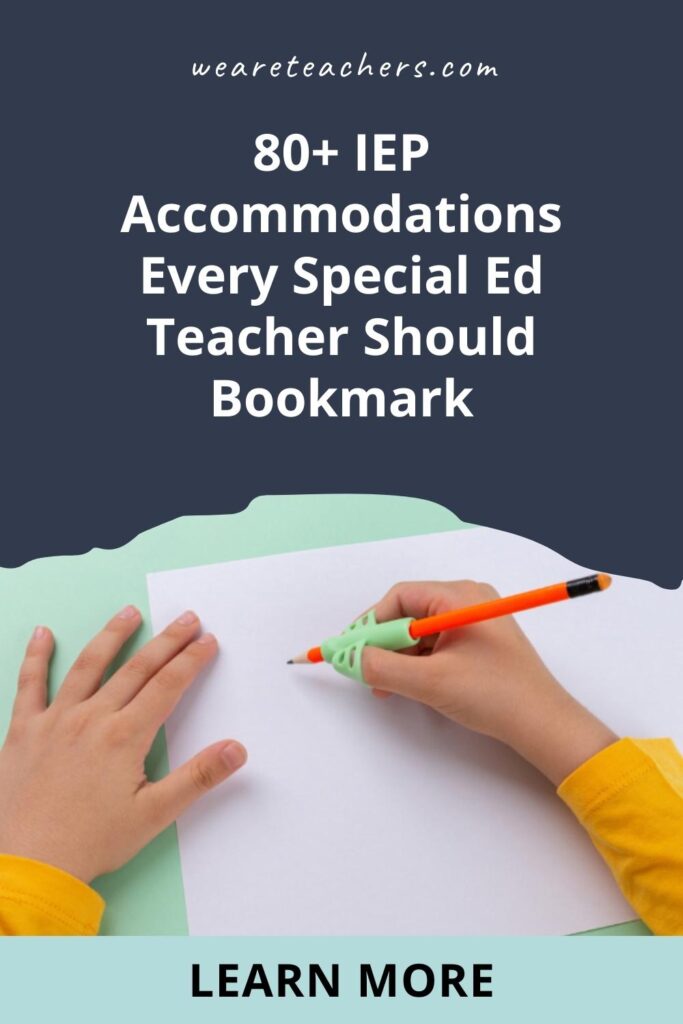Accommodations may be buried in an IEP—usually listed after the specially designed instruction and service time—but they’re important. Accommodations are all about how a child with a disability will access the general curriculum. When provided thoughtfully, accommodations make all the difference for students who need a different way of accessing information and showing what they’ve learned.
Here’s our comprehensive list of IEP accommodations you can use to design each student’s plan. Use this list and what you know about the student to design a plan that works for them. There is no right number of accommodations, but each accommodation should help the student and not overwhelm them.
IEP Accommodations for Students With Learning Disabilities
This is a list of accommodations that could be helpful for most students with IEPs.
- Provide instructions orally
- Provide text on audio tape
- Reduce the number of items per page
- Provide a designated reader
- Allow for verbal responses (could be talk-to-text or a scribe or a tape-recorded answer)
- Permit responses to be given via computer
- Allow frequent breaks during independent work (once every 5 minutes, for example)
- Present work in chunks (break a longer assignment into manageable chunks)
- Provide a way to block extraneous information on classwork (a blank sheet of paper to cover sections that the student is not working on, or a window to show one math problem at a time)
- Provide additional practice for core skills
- Provide a content area glossary or reading guide (for older students)
- Repeat directions
- Provide frequent check-ins to ensure the student is on task
- Provide assignments with the most important aspects highlighted
- Provide assignments with problems ordered from least to most difficult
- Provide models of completed or exemplar assignments
- Provide additional time to complete in-class assignments
- Provide preferential seating (near the teacher, away from distraction)
- Provide visuals alongside verbal information (writing directions on the board and stating them, for example)
- Use of a calculator on math assignments
- Reduced homework assignments
IEP Accommodations for Testing
- Permit responses to be recorded in a test booklet
- Allow frequent breaks (every 10 minutes, for example)
- Extend allotted time (by 60 minutes or double the time permitted for the test)
- Administer the test in a small group setting
- Administer the test in a one-on-one setting
- Administer the test in several sessions or across several days
- Allow students to take sub-tests in different orders
- Administer a test at a specific time of day
In addition to the accommodations for learning disabilities, these accommodations are also good for students with dyslexia:
- Provide audiobooks
- Clarify or simplify written directions (underline or highlight important parts of directions)
- Provide guided notes
- Provide printed notes before the lesson
- Highlight essential information in a reading or textbook
- Provide guided or pre-copied notes
- Provide a graphic organizer to support note-taking and organization
- Provide choices for how the student presents information (selecting from options, underlining answers)
- Provide extra space for writing responses
- Allow student to write on a whiteboard or tablet writing app
- Provide a specific type of writing paper to support handwriting
- Allow student to complete writing assignments early
- Allow student to type assignments rather than handwrite
- Remove “neatness” or “handwriting” from grading criteria for writing assignments
- Provide worksheets with all problems provided so the student doesn’t have to copy any work to their worksheet
- Provide a model or reference sheet for letter formation
- Permit the use of spellcheck or do not grade spelling for handwritten assignments
- Permit student to turn paper sideways for math assignments
- Provide pencil grips
- Permit student to write in different colors
- Provide visual supports (schedules, first-then strips, checklists, directives)
- Limit oral language when presenting directions
- Use reinforcement (token board)
- Pair verbal directions with visuals
- Provide social stories
- Provide social supports
- Provide an organization system
- Limit distractions in classroom (limit posters on walls)
- Provide assistive technology (low- to high-tech)
- Allow use of fidgets
- Allow flexible seating (wobble stool, standing, rocker)
- Provide access to a calming corner or sensory room
- Schedule movement breaks
- Allow extended processing time
- Provide sentence or paragraph starters
- Provide a self-editing checklist
- Provide lists to support writing or math work (transition word list, math operations word list)
- Provide access to noise-canceling headphones
IEP Accommodations for Students With Emotional Disabilities
- Break tasks into smaller chunks
- Provide frequent breaks
- Allow opportunities to use a pass to have a break from work
- Offer choice in how they access and present material
- Frequent check-ins with teacher
- Use a nonverbal cue to communicate negative behavior
- Provide immediate feedback on behavior and work
- Provide seating near a positive role model
- Provide a seating assignment for classes and lunch
- Provide visual of the daily routine
IEP Accommodations for Students With ADHD
- Provide use of assignment book or calendar for organization
- Flexible deadlines for assignments
- Provide checklist to stay organized
- Provide a table or desk divider to support focus
- Allow submissions of revisions or corrections
- Provide extra processing time or additional wait time to process information
- Provide text in large print (their assessment will determine the size of the text)
- Provide notes and text in braille
- Provide verbal descriptions of visual aids
- Provide computer with optical character reader and voice output
- Provide special acoustics (like an audio amplifier or assistive listening system)
- Provide sign language interpreter
- Provide note taker
- Provide speech-to-text
- Provide captioning
Plus, check out IEP Accommodations vs. Modifications: What’s the Difference?




















